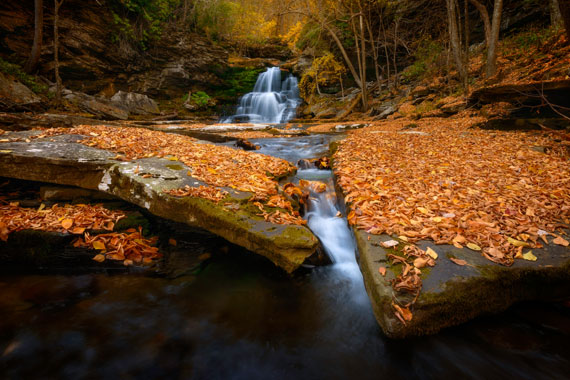Fall. One of the best times of the year to head out into the woods to take some spectacular photos! Rust and cherry red, sunshine yellow, lime green, bronze, tangerine, and lemon. The autumnal season foliage boasts colors rarely seen in such abundance in nature.
No surprise that it’s one of Mark Denney’s favorite photography subjects and times of the year, then. In his latest lesson, he details all the tricks he uses to leverage the most out of the show of color.
Plan Your Trip Ahead
Like a blanket, autumn slowly falls across the forests and foliage of the land. As such, it can be challenging to deduce whether or not it’s hit in the area where you plan to shoot. Being a native of the USA, Mark uses the Fall Foliage Prediction Map to plan. Simply move the slider to predict areas where and when fall will hit within the USA.
Bad Weather Can Be Good
Another consideration of your fall photography is the weather. Over fall, Mark believes there’s no such thing as bad weather. Otherwise known as the good-bad weather rule, that fog, cloud cover, and overcast days can be a blessing. Really bringing out the bright colors of the season.
To predict “good-bad” weather, Mark uses his weather app. However, he also shares his insider tip. Whenever the dew point is within 2-3 points of the feels-like temperature, that’s a pretty good indication of fog.
Minimize Busyness
Autumn scenes can be quite busy, what, with all the fall foliage, trees, and various colors jostling for attention. If you want to highlight a subject, a blurry background is a must. Mark recommends using a lower aperture to get a shallower depth of field. Your subject will then be the star of the show. Whereas any warm or busy foliage behind it will blur complementarily into the background.
Keep Your White Balance Warm
…whenever you’re photographing a fall scene, it can kind of mess with your cameras metering system a little bit. It’s kind of taking into account all of the warm tones and the colors. And a lot of the time, it’ll pick a white balance that’s far, far too cool…
Be aware of your white balance settings, as they can tamper with a fall scene due to all the warm tones. Your camera will generally opt for a white balance that’s very cool to compensate, spoiling your raw image. Instead, select the cloudy, daylight, and shade white balance settings on your camera to boost the warmth.

Photo captured by Gerald Berliner; ISO 100, f/8.0, 0.5 seconds.
Pack a Polarizing Lens
Play around with a polarizing filter to increase the contrast and vibrancy of select objects in your view. As a polarizer blocks brightness, it’ll help you pick up the unique leaf shades instead of any glare on them.
To calibrate your polarizer, Mark suggests moving it until your histogram stops moving to the left. When it starts moving to the right or getting lighter, you know the polarizer has reached maximum polarization.
Try Alternative Compositions
You don’t always have to train your camera directly on color-changing trees or bushes. Sometimes, accenting fall foliage as a supporting character is enough. A few sunshine-yellow leaves on a mossy rock or strewn on the side of the pathway still spell autumn. In particular, singular leaves make some of the best subjects.
The intricate details, as well as various warm colors and textures therein, are amply interesting enough to capture viewers’ eyes. Also, try to maximize color contrast in your shots. Though fall scenes are generally colorful, you can go one step further by selecting strongly contrasting subjects. Birch trees, with their white, striped bark, for example, add an extra dimension to a scene.
Mark’s Go-To Fall Photography Post-Production Tools
Mark also utilizes post-production editing software to perfect his autumnal photography. Here are his top three tools and tips.
The Calibration Tool
Use the calibration tool in your editing software to boost and separate each color. Greens, reds, and yellows will be the most abundant in fall scenes. So try to maximize these hues individually with it for the best results.
Color Grading
Color grading can help you throw warm lighting onto other central but not as warm image accents. Mark selects the off-white preset on Lightroom, slightly amping up the yellow autumnal highlights in the rushing waterfall.
The Luminance Tool
Do you want to ramp up the vibrancy of select colors, particularly in images featuring different colored leaves? If so, the luminance tool is very efficient at doing so. Use it to make those final vibrancy corrections on any specific shade of leaves that has gotten lost.
Wrapping Up
Fall photography is a popular subject, featuring hues, textures, and displays that are rich and eye-catching. However, as Mark illustrated in his vlog, there are many things photographers can do to boost their fall photography. Try some of his tips and tricks out this coming autumn!
Like This Article?
Don't Miss The Next One!
Join over 100,000 photographers of all experience levels who receive our free photography tips and articles to stay current:




